Guerra, a Spanish Treasure where Forestry and Technology Unite
Whenever anyone mentions Spain my first thoughts are sun, sea and Sangria. However, my recent trip to Northern Spain has completely changed my views. I was invited to join Graham Johnston, from Forest Machine Services Ltd (FMS), in Wark, Northumberland, on a trip to the Guerra factory in Vila de Cruces, Pontevedra near Santiago de Compostela in the Northwest of Spain.
Although I had previously heard of Guerra and knew they manufactured forestry trailers, it was a product I had not had experience with. After my invitation I checked them out and realised they were a much larger company than I first thought, offering an impressive range of forestry, marine and recycling equipment.
I met up with Graham Johnston, of Forest machine Services Ltd, at Newcastle Airport for our three-flight journey to Santiago. We arrived in Madrid to a nice sunny day with a temperature of around 20°C; it was like walking into an oven as I was all wrapped up having left in sub-zero temperatures. When our final flight landed in Santiago, I thought the pilot had got lost and made a wrong turn as it was cold and wet and I began to think I had packed the wrong clothes.
We cleared customs and were met by our guide, Brais Alonso, who works in sales for Guerra and would be taking care of us during our stay. We checked into our hotel, dropped our bags and set off with Brais for a tour of Santiago de Compostela, which is the capital city of Galicia.
Although it was wet this didn’t dampen our spirits whatsoever as there was so much to take in – we saw the magnificent Cathedral and beautiful buildings of the old town. The Cathedral de Santiago is famous as the culmination of the pilgrimage route which attracts people from all over the world. It is the alleged burial site of the Biblical apostle St James.
Guerra Factory
Brais met us after breakfast the following morning and firstly took us to one of Guerra’s manufacturing plants. This facility was very modern and included the latest line boring equipment and lathes. We saw steel rods being machined into geared kingpost bases, a tree shears chassis being prepared, and main, dipper and extension booms being drilled for attaching hydraulic cylinders. According to Brais, this is just one of the many machine facilities that Guerra has locally. The main headquarters that held the offices and final assembly facility had reached its expansion capacity, so other manufacturing premises were found locally to ease the pressure and free up space in the HQ. Guerra also use a few local engineering workshops that carry out welding work for them on a sub-contracting basis.
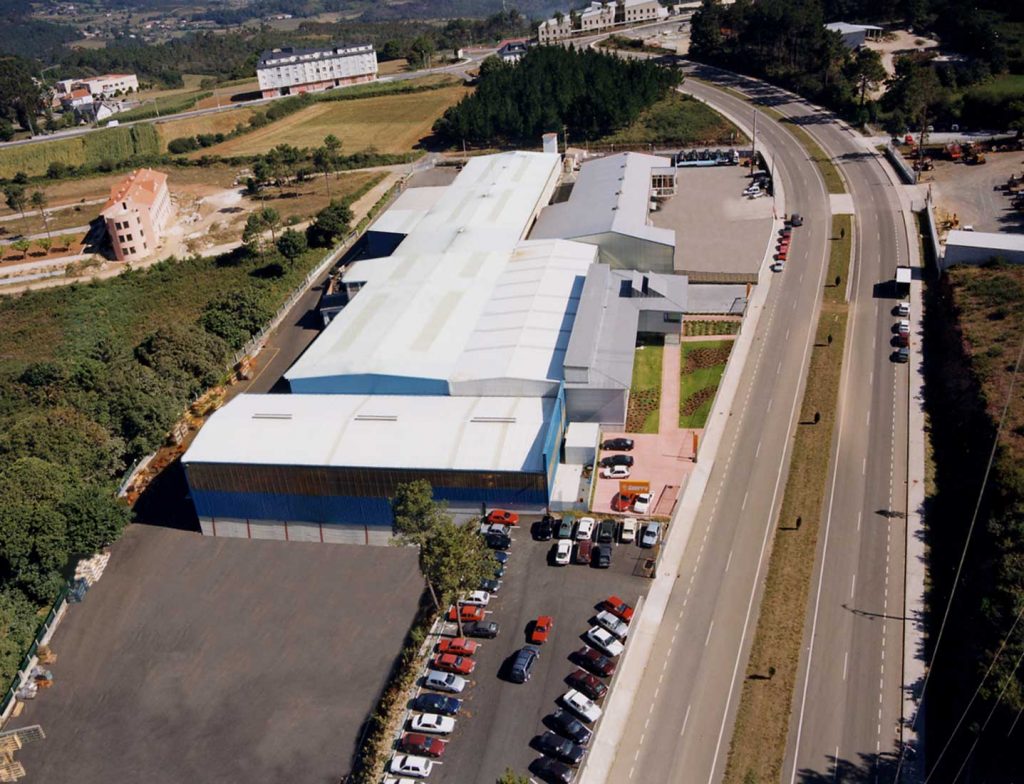

Arriving at Guerra HQ, I was taken aback by what I saw; it was much bigger than I had imagined and even on this dreich day it still looked mighty impressive and welcoming. Brais took us into the reception area where we were welcomed by the owner and general director Roman Sanchez Gonzalez. Roman speaks English about as well as I and Graham speak Spanish, but luckily Brais was able to interpret for all of us.
DESIGN AND PRODUCTION
The offices were stunning with spacious and modern air conditioned workplaces for the administration and sales staff spread over two floors. On the upper floor we were greeted by Roman’s son Ricardo, the sales manager. Ricardo took over the tour of the engineering and assembly plant, starting with the bending and fabrication area.
All the metal sheets (forestry uses Strenx 700 and the marine division uses Strenx 900) are cut using a plasma cutter and shot blasted prior to applying primer and paint. The majority of welding is done by robotic welders, the workers will spot weld the components together before being placed in the automated welding booths.
Ricardo explained more about the company as he guided us around. Guerra have been manufacturing for 65 years, with an annual turnover of €15 million. They are the largest employer in Vila de Cruces, which is a small town with just under 3,000 inhabitants. Wages are relatively low in this region and many of the workers have their own farms and are self-sufficient as farming provides them with meat, eggs, milk and vegetables. Deer, wild boar and pheasants are in abundance and are hunted for food and there is plenty of good quality fish in the rivers, lakes and the sea. The people I met and spoke to put more value on enjoying life and being content with what they have rather than searching for a higher paid job. 110 people are employed and the company has facilities in Spain, Portugal and Argentina.
The Portugal and Argentinean facilities sell and install Guerra equipment, all the manufacturing is carried out in Spain and shipped from there. Their products are sold in over 35 countries, with overseas sales accounting for around 40% of their total production. However, like everywhere Spain is suffering badly from a skills shortage; the country’s unemployment figure is 3.5 million, and it is difficult to get good workers. Guerra work along with the local schools and offer five welding and five mechanical engineering apprenticeships every year.
The company produces an impressive range of first class products including forestry trailers, forestry cranes for tractors, forwarders, log trucks and statics for wood processing, harvesting heads, tree shears, timber grapples, winches, and hydraulic power packs; they also carry out forestry conversions/ guarding on tractors and excavators which are ROPS and FOPS compliant and certificated.
A further production line involves a range of cranes for the marine and recycling division, with approximately 60% of their cranes manufactured for marine and recycling and 40% for forestry use. Most components, including hydraulic cylinders, are manufactured “in house”. The exceptions are the rotators, which are manufactured by Indexator of Sweden and all the other hydraulic components (pumps, valves, fittings etc).
When Guerra was first established Bilbao, which was a considerable driving distance away, was the hub for industry and this led to the decision to manufacture “in house.” This is not the case anymore as Spain has evolved over the decades with good local engineering and industrial facilities and a much better road infrastructure.
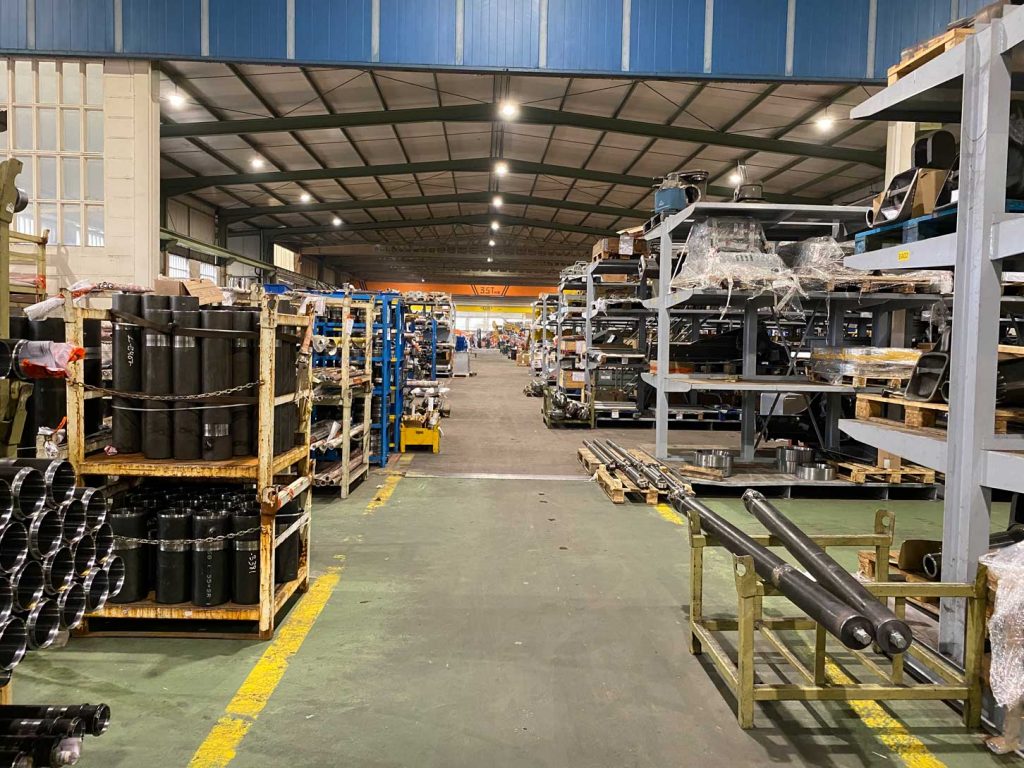

The fabrication area was a treasure trove of crane bases, king posts, grapple, harvesting head and tree shear parts, boom components, and all the other parts needed for assembling the equipment made here. It was a mass of noise with the atmosphere smelling of electricity from the welding taking place; it was exciting to be there as it was a jamboree of organised hustle and bustle.
The upper area was massive with the first section packed with hydraulic cylinders of all sizes stacked on shelves; there were literally thousands of them. This was the hydraulic area and all the rubber pressure hoses are cut and crimped with the fittings here as well. The first half of the workshop (larger than a football field) was shelved with every part imaginable: bogies, hubs, grapples, rotators, bolsters, etc. are all present, with each row of shelves labelled alphabetically so every part is easy to locate.Looking out towards the other end I could see cranes, excavators, harvesting heads, tree shears, and it was all I could do to contain myself and not start running off in all directions.
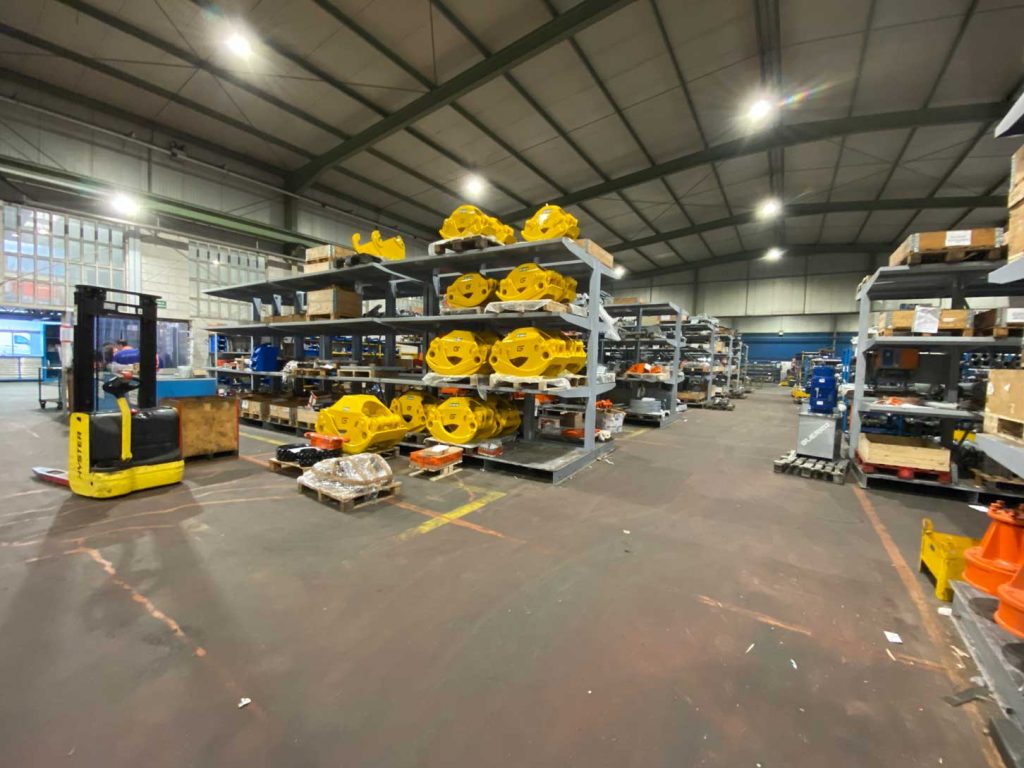

Ricardo’s knowledge was remarkable and he could answer any question myself or Graham had – it was clear just how passionate and proud he was about what they were creating.
He explained that the construction of the marine cranes is very different to forestry cranes as all the components have to be zinc coated so they are corrosion proof to withstand the salty sea conditions. All the nuts, bolts, bearings and fittings have to be made using stainless steel. Even the rubber for the hydraulic hoses is a different compound and this can make the marine cranes up to seven times more expensive to manufacture compared to the forestry ones.
Ricardo clarified that they manufacture 300-500 crane per year, and this total is determined by the size and type of crane; a small forestry crane can be made quite quickly in a few days but a large crane may take weeks.
As we approached the middle of the factory, I started to get an idea of just what a comprehensive assortment of forestry equipment was being manufactured. They have a lot of hydraulic winches which are side mounted on the main boom of the cranes or mounted under the main boom on excavators. These are very popular and are relatively inexpensive additions. Most contractors and hauliers opt for them as they are useful for bringing timber that slips down the bank back into reach of the crane (Eucalyptus is extremely slippery as the mills pay extra for completely removing the bark).
One unit which was finished and ready for delivery was a big tree shear, a strong, robust piece of equipment that looked like it would withstand rigorous treatment from the “not so gentle operators”.


Next to it was a Guerra harvesting head fitted with Eucalyptus rollers for debarking the stems. These can be supplied with normal rollers and used on excavator or purpose built harvester bases. Both can be attached by a quick hitch system and use the Motomit computer system, meaning they are interchangeable if necessary.
We were re-joined by Brais, who apologised for his absence; it was a crazy busy time for them as the Government had a grant scheme available for purchasing new forestry equipment for contractors but applicants only had a four-week period to apply.
The knowledge both Brais and Ricardo had regarding Guerra products was astonishing and the more questions they were asked, the more happy they seemed to be.
GF 83N CRANE
While there were a lot of both forestry and marine cranes being finished off in this section, I spotted another crane which was intriguing; it was a forestry crane with its own engine attached to it. It had a 75hp diesel motor with a large hydraulic pump and would only use about 5l of diesel per hour. I asked Ricardo about this and he explained that it was a self-sufficient truck loader that is popular in Spain. The truck chassis is specially adapted for this crane, meaning a haulier can have a wide range of trucks and trailers and just the one crane. The kingpost is slightly offset so that a cabin can be fitted as the design means that the crane has to be able to travel inside the bolster pins. It sits on its own legs and the truck reverses onto it, then the driver jumps onto the crane and it has its own drive system for moving itself up and down the trailer’s chassis. This means that the crane doesn’t need a long extension on the dipper or sliding bolsters as it is the crane that moves up and down the chassis.
Ricardo was grinning while he explained the clever advantages of using this Guerra system.
“When loading the truck engine is switched off, which means the driver has more driving hours each day. With no crane on the truck they can also carry more timber and it is less costly for the owner as each loader can be used by multiple trucks. In slippery conditions the loader can be parked at the front of the trailer over the tractor unit’s drive axle, providing significantly more traction.” This is ideal for working with shortwood – the wood being cut is typically Eucalyptus for pulp/chipwood or Pine for construction.
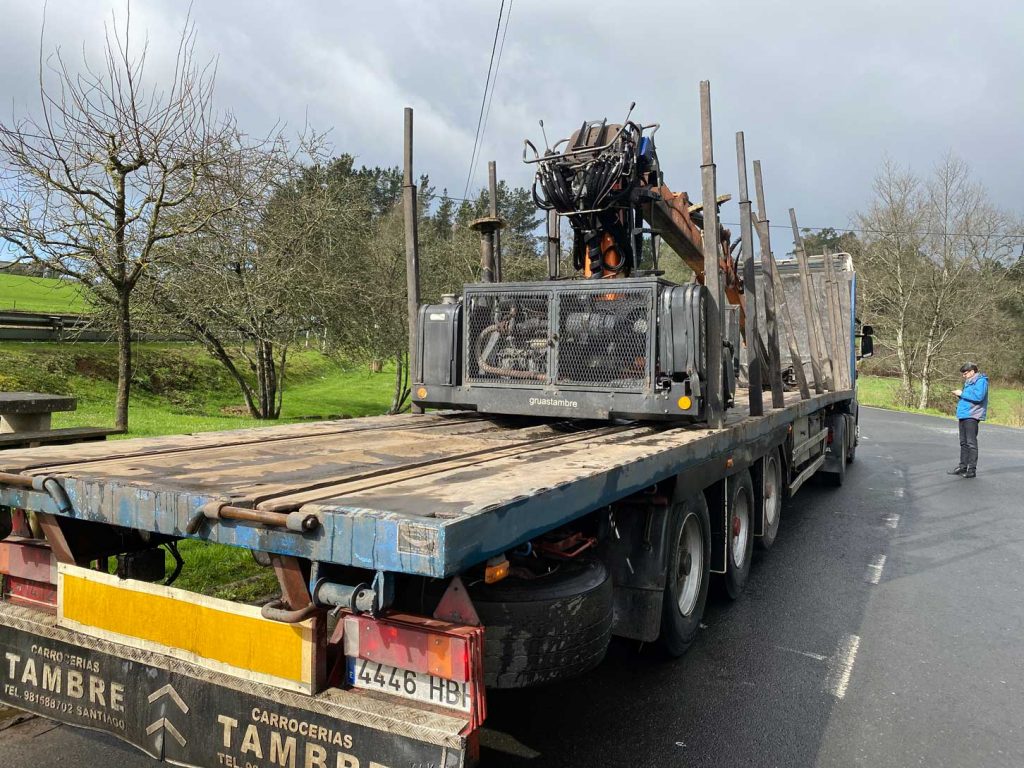

At the end of the workshop, three large excavators were being worked on. The first, a Caterpillar, was having a service and its attached tree shear refurbished. This was the first tree shear Guerra had manufactured and the base it was fitted to was a Cat that had been used for over 7 years as a harvester before being fitted with the tree shears almost 4 years ago.The machine had completed 25,000 hours and was still in good working condition; testament to a good operator who carries out regular maintenance.
Ricardo told us that in Spain most excavator harvester bases carry out 14-20,000 hours work in a 7-10 year period, some contractors overhaul the base base and fit them with tree shears as the work is less demanding on equipment and it is a smaller investment.
The new Doosan Excavator was in the process of being guarded and kitted out for use as a forestry timber harvester. The door into the Doosan was removed and another much stronger one had been manufactured by Guerra as a replacement. Ricardo explained that they are the only Spanish company whose engineering conforms to ROPS and FOPS certification on their cabin modifications when converting excavators for forestry use.
Outside the main building we saw some shiny new excavator/harvesters/tree shears that had been completed and would soon be departing for a new life in the forest. We then walked around the other side of the building to see some trailers and a forestry Valtra Hitraf tractor conversion.
The tractor was stunning in black and white livery coupled up to a R16 short trailer for crossloading. The Valtra had a rear axle mounted 7.5m reach double extension 74A series crane with stability legs, a front blade, front and crane mounted winch, and full forestry guarding. The trailer set up is completely different to the UK as they are designed for cross loading 2.5m lengths of Eucalyptus, which is their main species of timber. This trailer had open sides, meaning it was designed for extracting unpeeled wood. Some Eucalyptus is transported by train to a pulp mill in Portugal and this timber has to be peeled to reduce weight and waste, for which the contractors are paid a higher rate per m³. By law, because it is very slippery, it must be extracted and transported by trailers and trucks with solid sides so they cannot shed loads.
Next, the four of us went for lunch at a family run restaurant serving homemade Galician soup to start. This was followed by a main course of bear steaks cooked on the bone and cow’s cheeks, rounded off by a selection of delicious sweets and coffee.
SPANISH FORESTRY
Forestry in Spain is much more extensive that I expected; they have 14.4 million hectares of forest cover, which is increasing by 86,000ha/yearly. In terms of forest resources Spain is the fourth largest in Europe behind Sweden, Finland and France. Most of the productive forests are found on the Atlantic coastal zone and comprise of mainly Pine, Eucalyptus, Oak, Beech and Silver Fir. The majority – approximately 80% – are privately owned and the other 20% are state owned.
The afternoon visits were out on site to see some of the Guerra equipment working.
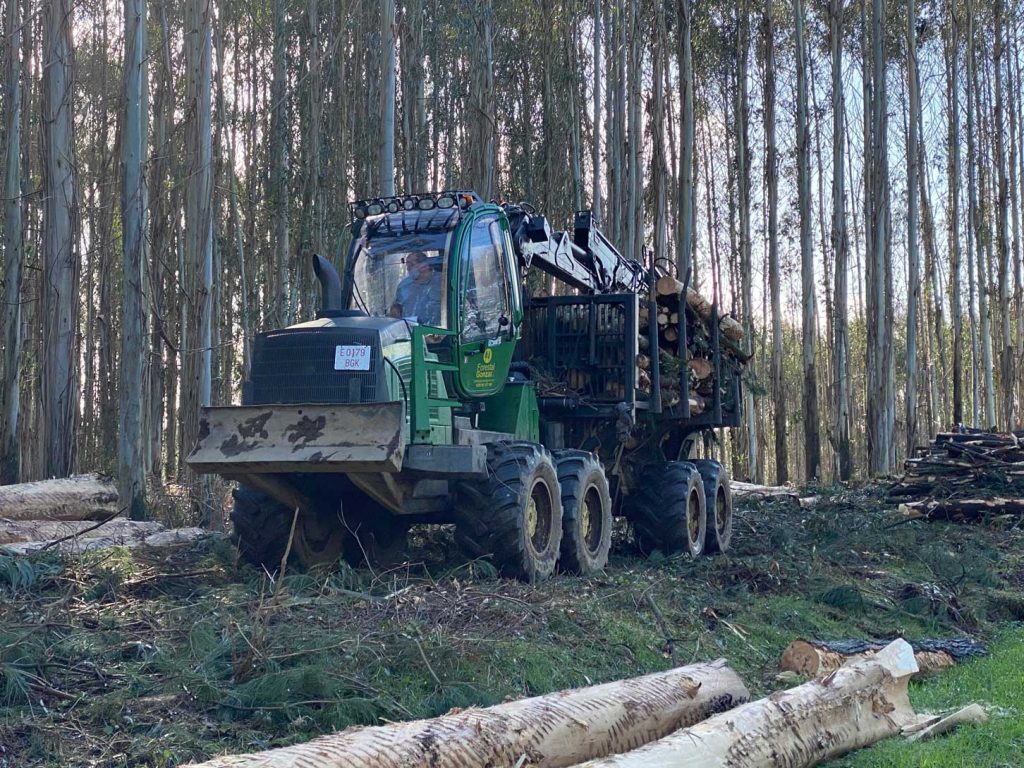

Our first visit was to a flat Eucalyptus forest being felled by tree shears, processed with a harvester and extracted by a John Deere 1210 forwarder. Thereason for this type of operation is that they like to cut the trees at ground level and using the shears allows this. The soil was quite gritty and the harvester operatorwould have to be constantly sharpening chains. This is such a quick cycle; the Eucalyptus reaches maturity at around 14 years old so it is a quick-growing and sustainable product for wood pulp and chip wood. Some sites have the brash harvested for chip wood, but normally it is mulched and then manually replanted.
The privately owned forests in Spain have decreased in size as they have been passed on to family members, i.e. a grandfather who owned 2ha would leave it to his two sons and they would leave it to their two sons, meaning there are now four .5ha forests. This meant that trying to find where equipment would be for us to see working was difficult – most sites only involve two to three days of harvesting work as equipment is always on the move.
Most contractors purchase the wood from the landowner and resell it to the mills as opposed to being paid by the m³.
Next was a larger volume harvesting site being cut by the harvesting company Maderas
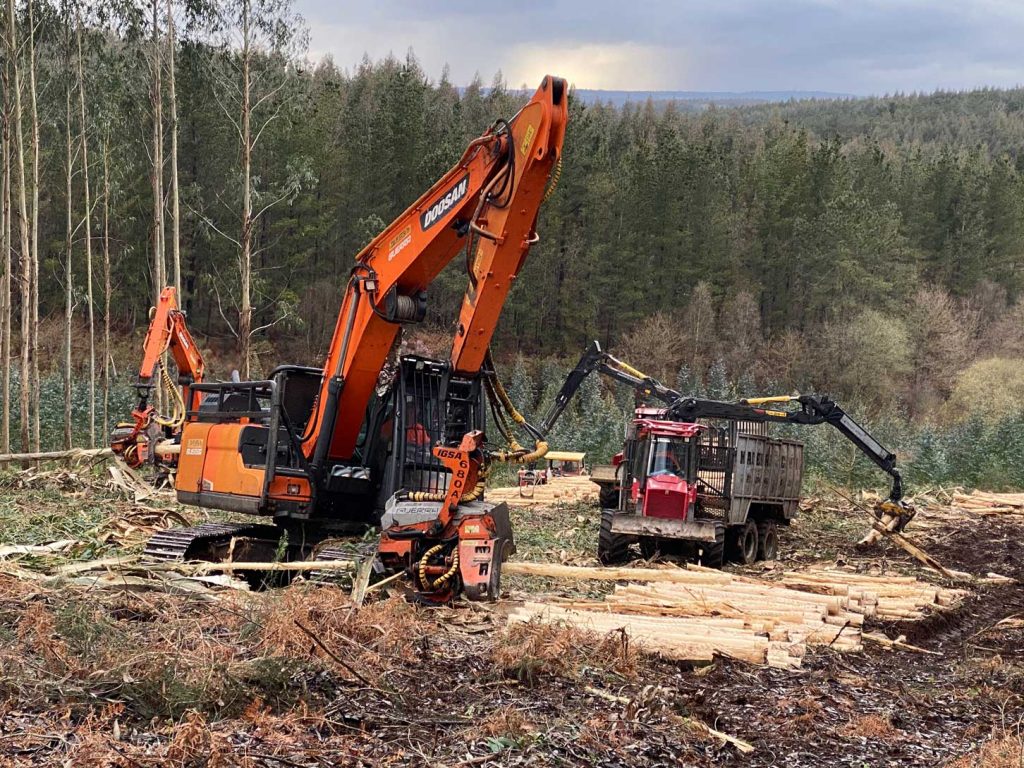

Carril, who carry out a lot of timber harvesting in Galicia and have their own fleet of timber trucks for transporting wood. On this site they had a Hyundai excavator with the Guerra TC600 tree shear, which was felling 160-180 trees per hour, two Doosan excavators with Guerra 680B harvesting heads, and a Komatsu 860 and 895 for extraction. The wood here was being peeled and the Eucalyptus harvester rollers worked well for de-barking. The tree was spinning as it was being fed through. The forwarders had a completely different layout as they were cross loaded instead of loaded in the bunks. They had solid sides to prevent the wood from slipping off, with a front headboard and two rear bolsters to hold the wood. As a result, the load was secure regardless of the terrain. Although it was wet and about a 20% uphill extraction slope in places, the forwarders coped easily with TRS tyres and there was no visible ground damage whatsoever. This was a productive operation carried out by professional operators.
Ricardo and Brais tried to organise a visit to see a motorised crane in action for our final visit of the day, but this proved very difficult as finding one loading locally that we could reach in time was nearly impossible. Luckily, we saw some that were parked up for the night and this provided an opportunity to see exactly how they would work.
The evening ended with a fantastic meal at a Santiago steakhouse, washed down with some local red wine.
Back out on site
Brais picked us up in the morning so we could observe some of the larger R16 trailers working; these are very popular as on smaller volume jobs they are road legal with a good road speed for transporting themselves between sites. We saw one extracting up a steep bank and the grip the operator was getting was impressive in the greasy conditions. The trailer was being pulled by a 180hp Case tractor and the drive on the trailer was superb.


It was after watching the operator unload I realised he had extracted in excess of 15 tonne of Eucalyptus without any wheelspin on the hard pull. The trailer drive works via a hydraulic PTO pump (which also supplies the crane and steering drawbar), which feeds two hydraulic motors on the trailer’s differential. The half shafts then drive the geared trailer bogies. Each wheel also has its own internal disc brake activated by hydraulic pistons. The trailer drive has a retarder, which reduces the push and the need to use the brakes on the tractor when driving downhill on steep and slippery conditions. The diff lock system on the trailer works by way of a flow divider.
Band tracks are not an option on the trailer, there is not a lot of clearance for them but for additional traction wheel chains can be fitted. Being realistic you should not be looking at trying to carry out harvesting work with a trailer where you would need to use band tracks, this kind of work should be done with a purpose built forwarder.
The crane on the trailer was immense; the timber being unloaded was large in diameter yet the crane was handling it easily. It was very smooth in operation and had the electric two-lever control system for the seat. This site was being harvested and crosscut by chainsaw operators, and the majority of the local timber is still harvested this way.
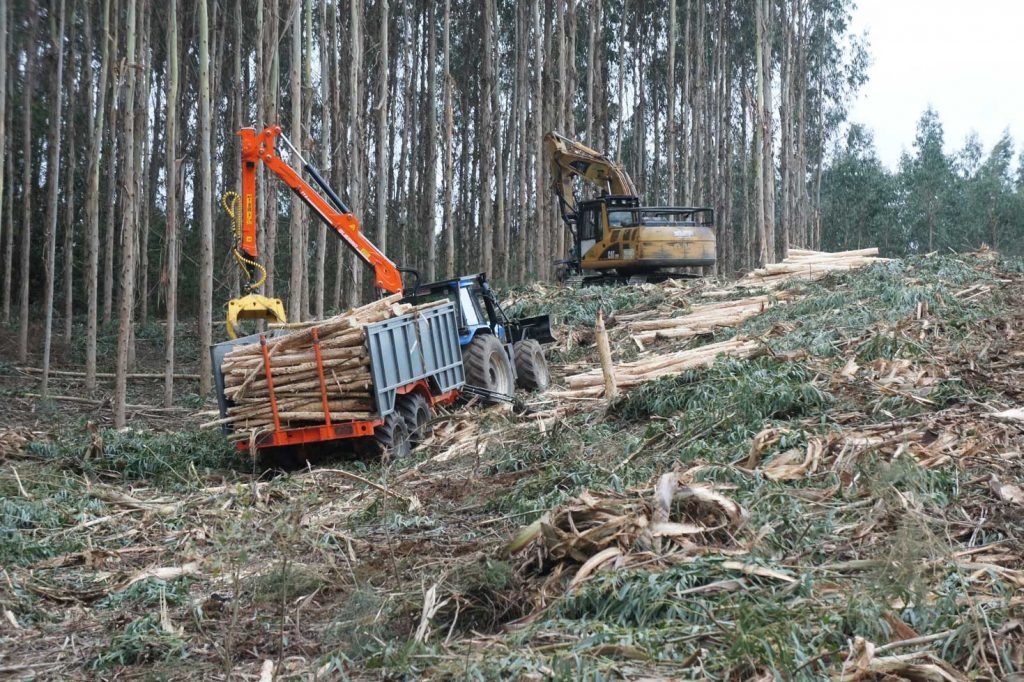

After seeing a bit more of how forestry is carried out in Galicia it was time for us to get prepared for our early flights home the following morning and, as luck would have it on the way back to our hotel, we stumbled across a truck in the process of picking up a motorised crane, so we’re delighted to have managed to see everything we wanted to.
FINAL FAREWELL
Our new friends Roman, Ricardo and Brais joined us that evening for a final farewell drink before we regretfully had to say hasta la vista. Our trip home to the UK would involve three flights again including missing our final one to Newcastle at Heathrow, but that’s a story for another day!
I wasn’t sure what to expect regarding this trip but was blown away by the quality of Guerra’s engineering and the hospitality of our hosts. A big thank you goes out to Graham Johnston and Stephen Willis of FMS Ltd for making this happen – it was a brilliant visit and a real eye opener.
Guerra in the UK
After visiting the factory I thought it would be a good idea to catch up with someone using Guerra equipment in the UK.
Rob McCready has just purchased a new Guerra R16 trailer from FMS. It is equipped with a 1300HD 4WD system, an electro-hydraulic hill descent control system, a differential locking system, and a 67A crane for use with his Valtra T153 tractor.
This is Rob’s second Guerra trailer – his last was a Guerra R12 model which was 13 years old and had extracted around 100,000 tonnes of timber when he traded it against his new one.
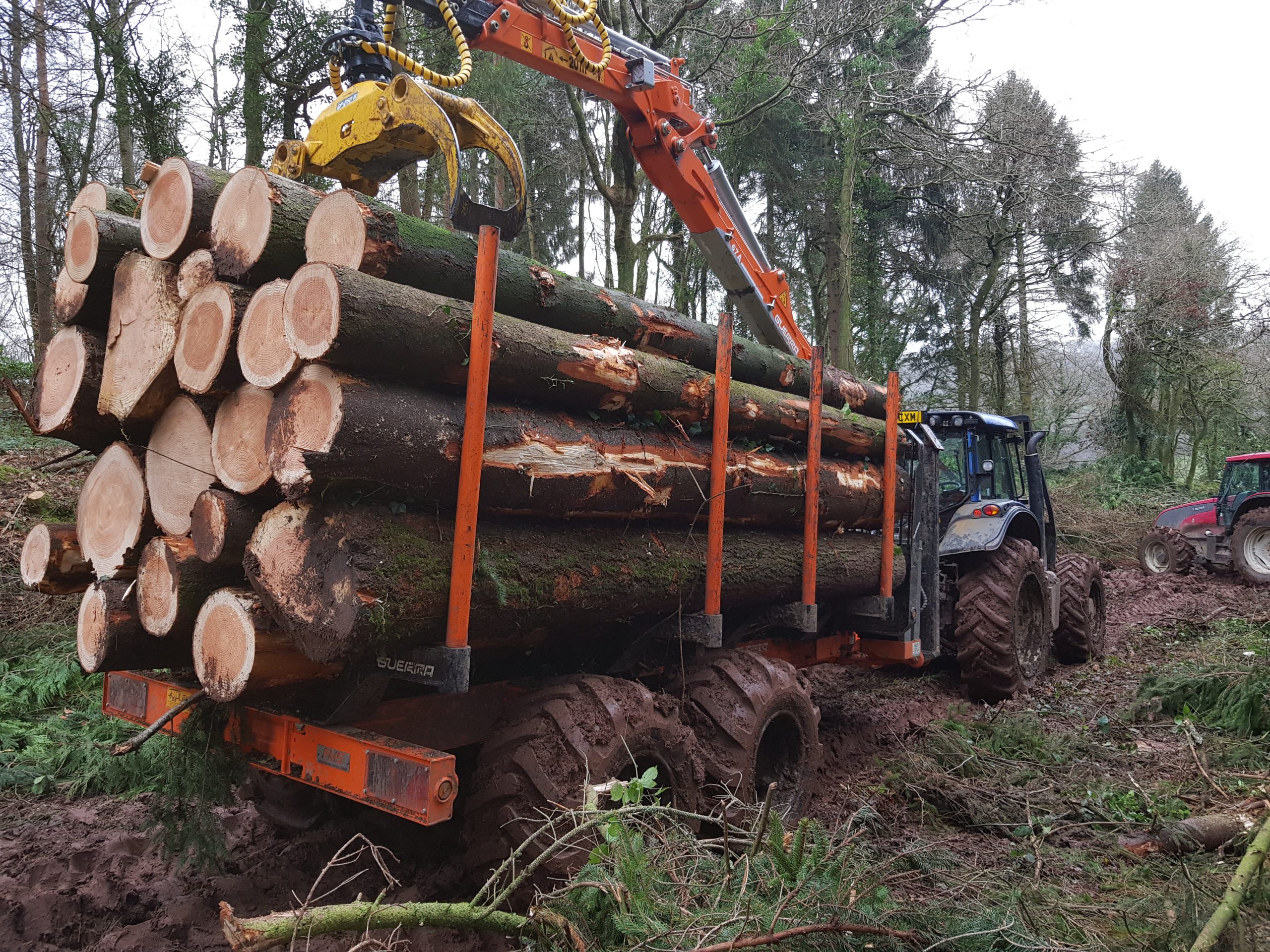

His success with his previous Guerra trailer, which he had owned for 10 years, had a big influence on his choice of brand when purchasing his new one. It had been pretty much trouble free and had only needed a couple of minor welding repairs on the crane; the original grapple was still in place and functioning well. When the repairs were taking place, the welder had commented on the excellent quality of the steel. Rob does admit that he looks after his equipment and carries out regular maintenance, but even so the quality of the components used by Guerra means he has never had to change a bush or bearing in the loader.
Rob carries out a variety of work for his clients, mainly working on private estates and woodlands.
He needs equipment that will work effectively in both clearfelling and thinning sites yet remains robust enough to handle large hardwoods. The harvesting compartments vary significantly in size, so a road legal tractor trailer combination forwarder with a high road speed is ideal for travelling between smaller volume harvesting jobs.
Transporting equipment by lorry from site to site is not financially justifiable.
Rob uses another Valtra Tractor with a 10 tonne Tajfun Winch for any awkward or steep harvesting areas, which he does a lot of, and then the trailer for secondary extraction. His work involves harvesting some timber into 2.5m lengths and this was an awkward size for his R12 trailer as he could only carry a single bay. The last 15 months have been spent weighing up his best options on how to increase production.
UPGRADING
Rob decided on the new Guerra R16 trailer but was still a bit apprehensive over his decision to purchase the larger size; however, having now extracted over 1,000m³, he is delighted with his decision.
Although he was worried about the extra weight of the trailer and larger load pushing on the tractor on steeper downhill extractions, the trailers controlled hill descent function is an amazing feature that prevents skidding or sliding in greasy conditions. The steering trailer drawbar is excellent if it is necessary to traverse any side slopes; by angling the drawbar in an uphill direction, the trailer follows this direction and increases stability.
Ground damage and soil compaction were further concerns with going bigger, but he has found that with the wider and larger tyres with the TRS tread pattern there is actually much less of an impact compared to his previous trailer. The diff lock function, which he didn’t have on his previous trailer, works really well by greatly improving traction and this in turn helps to reduce any rutting.
There were a few personal modifications that Rob wanted, the main one being that he prefers the electric joystick controls on the tractors armrests for using the crane.
What particularly impressed Rob was that when the trailer was being PDI’d, the Guerra engineer who came over from Spain to assist FMS was the engineer who had built his original trailer. I met him when visiting Guerra and he has worked for them for over 30 years. Rob loves the Guerra 67Acrane on this trailer as it is strong and smooth to operate and really precise for sorting timber.
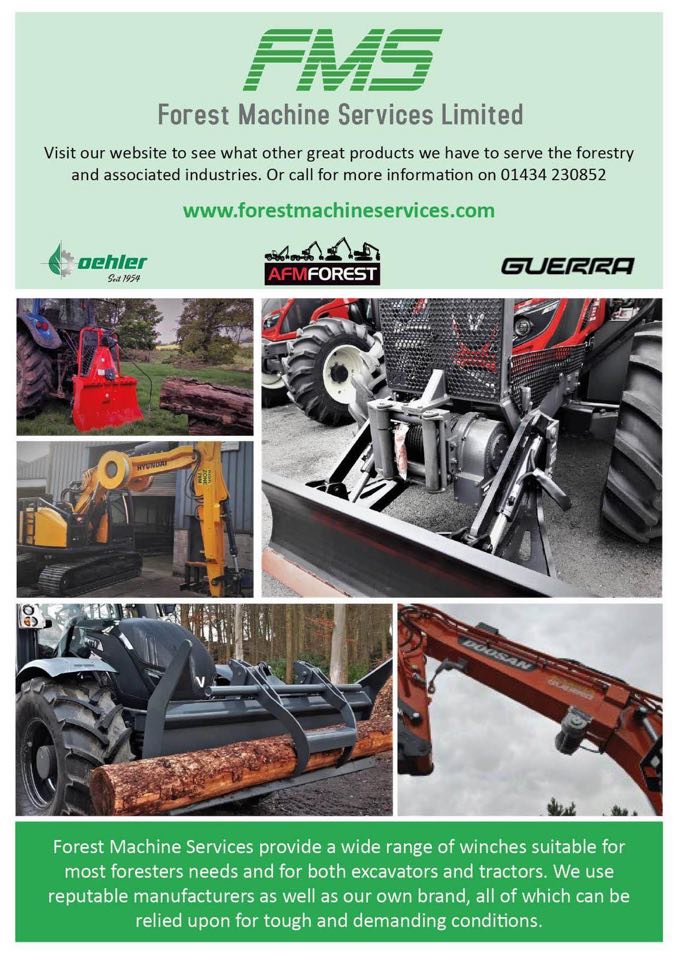

FOREST MACHINE SERVICES
Rob couldn’t praise FMS highly enough both before and after his purchase as it is easy to get hold of someone at FMS when you need any advice or assistance.
In summary, He is delighted with his Guerra purchase, the quality and efficiency of his trailer, and the service he has received from FMS.
Find us on Facebook
Forest Machine Magazine is written and edited by a forest professional with over 40 years hands on experience. We are dedicated to keeping you informed with all the latest news, views and reviews from our industry.
To support us you can subscribe to our bi-monthly magazine which is delivered to your door from only £30 per year.
Subscribe here

